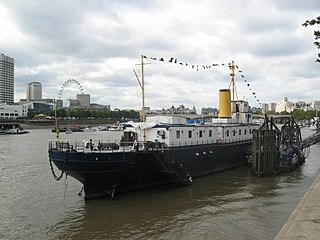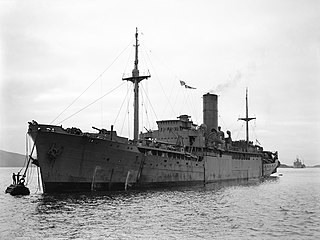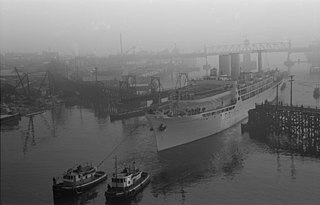
The PS Medway Queen is a paddle driven steamship, the only mobile estuary paddle steamer left in the United Kingdom. She was one of the "little ships of Dunkirk", making a record seven trips and rescuing 7,000 men in the evacuation of Dunkirk.

The Halcyon class was a class of 21 oil-fired minesweepers built for the British Royal Navy between 1933 and 1939. They were given traditional small ship names used historically by the Royal Navy and served during World War II.

HMS President is a retired Flower-class Q-ship that was launched in 1918. She was renamed HMS President in 1922 and moored permanently on the Thames as a Royal Navy Reserve drill ship. In 1982 she was sold to private owners and, having changed hands twice, served as a venue for conferences and functions as well as the offices for a number of media companies. She has been moved to Chatham on the Medway in Kent since 2016, but is due to return to the capital. She had the suffix "(1918)" added to her name in order to distinguish her from HMS President, the Royal Naval Reserve base in St Katharine Docks. She is one of the last three surviving Royal Navy warships of the First World War. She is also the sole representative of the first type of purpose built anti-submarine vessels, and is the ancestor of World War II convoy escort sloops, which evolved into modern anti-submarine frigates.

HMS Rifleman was a turbine-powered Algerine-class minesweeper of the Royal Navy. She was launched in 1943 and saw active service during World War II, both in the European and Far East theatres. After the war she served in the Mediterranean and was used as an accommodation ship in Barrow before being sold for breaking in 1972.

HMS Albury was a Hunt-class minesweeper of the Aberdare sub-class built for the Royal Navy during World War I. She was not finished in time to participate in the First World War and survived the Second World War to be sold for scrap in 1947.

HMS M29 was a Royal Navy M29-class monitor of the First World War. The ship was constructed by Harland & Wolff, in Belfast and launched on 22 May 1915, she was completed in June 1915. During World War I, the monitor served in the Mediterranean Sea at the Battle of Jaffa in 1917 and took part in operations in support of British and White Russian forces in the White Sea during the Russian Civil War in 1919. The ship was then converted to a minelayer and renamed HMS Medusa in 1925. In 1941 Medusa was converted to a repair and depot ship and was renamed HMS Talbot, then renamed HMS Medway II in 1944. In 1946, the vessel was sold for scrap.

HMS Loyalty was a turbine-powered Algerine-class minesweeper of the Royal Navy, formerly HMS Rattler. She served during the Second World War. Commissioned in 1943, Loyalty saw action off the coast of Normandy during the Allied assault there in 1944. While performing duties off the coast, the ship was torpedoed by a German submarine and sank.

PS Duchess of Montrose was a paddle steamer launched in 1902 and operated by the Caledonian Steam Packet Company as a River Clyde excursion steamer. She saw active service during the First World War after being requisitioned by the Admiralty and converted into a minesweeper. She was lost near Dunkirk on 18 March 1917 after striking a mine.
HMS Melton was a Racecourse-class minesweeper of the Royal Navy. The Racecourse class comprised 32 paddlewheel coastal minesweeping sloops.
HMIS Konkan (J228) was a Bangor-class minesweepers built for the Royal Navy, but transferred to the Royal Indian Navy (RIN) during the Second World War.

PS Caledonia was a paddle steamer built in 1934. She principally provided an Upper Clyde ferry service, later moving to Ayr and then Craigendoran.

PS Jeanie Deans was a Clyde paddle steamer, built in 1931 for the London and North Eastern Railway. She was a popular boat, providing summer cruises from Craigendoran until 1964.

HMS Vivacious (D36) was a V-class destroyer of the British Royal Navy that saw service in World War I and World War II.

HMS Cygnet was a two funnel, 30 knot destroyer ordered by the Royal Navy under the 1896–1897 Naval Estimates. She was the thirteenth ship to carry this name. She was launched in 1898, served in the Chatham division before World War I and was tendered to the gunnery school at Sheerness during the war. She was sold for breaking in 1920.

HMS Agamemnon was originally the Blue Funnel Line refrigerated cargo ship Agamemnon. She was built in 1929, traded between the UK and the Far East, and was scrapped in 1963. During the Second World War she was converted into an auxiliary minelayer in 1940, and then into an amenities ship in 1943.

HMS Menestheus was originally the Blue Funnel Line refrigerated cargo ship Menestheus. She was built in 1929, and traded between the UK and the Far East. She was an auxiliary minelayer from 1940 to 1943. In 1945, during the Second World War, she was converted into an amenities ship. She was scrapped in 1953 after being gutted by fire.

HMS Liberty (J391) was a turbine engine-powered Algerine-class minesweeper during the Second World War. She survived the war and was sold to Belgium in 1949 as Adrien de Gerlache (M900).

PS Princess Elizabeth is a passenger-carrying paddle steamer which was built by Day, Summers and Company in 1927 for Southampton, Isle of Wight and South of England Royal Mail Steam Packet Company Limited, that is noted for being one of the Little Ships of Dunkirk, and is now a static floating restaurant in Dunkirk.

HMS Brave (J305) was a turbine engine-powered Algerine-class minesweeper during the Second World War.

HMS Cheerful (J388) was a turbine engine-powered Algerine-class minesweeper during the Second World War.


















